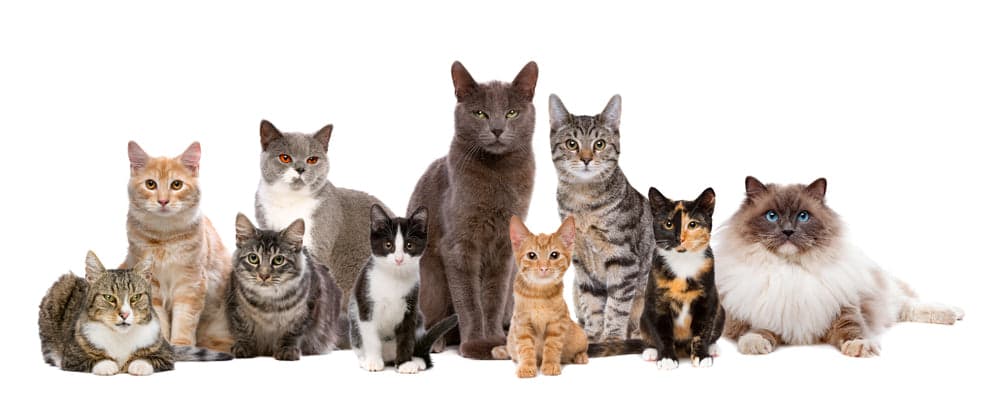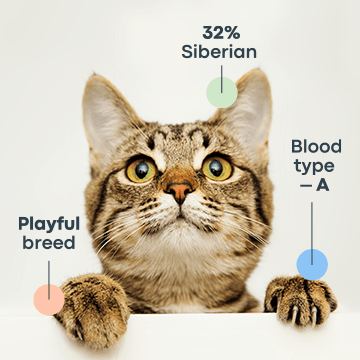How can you tell if your cat is fully grown? Learn about cat life stages and developmental milestones that can help you find out whether or not your cat has grown to full maturity. Know when to make important decisions that will help you best support their health and well-being, such as whether your cat is ready for adult cat food or at what age they should be spayed or neutered.
At What Age Do Cats Stop Growing? Life Stages of Cats Explained
Cats go through distinct life stages, each marked by physical growth, behavioral development, and changing care needs. Here's a breakdown of how your feline evolves from a tiny kitten into a mature adult and, eventually, a senior companion.
Kitten (0-6 Months Old)
Physical Growth:
Kittens usually double in size during their first week of life, typically gaining about 1 pound per month (or around 0.25 pounds per week). By six months, most kittens weigh between 5 and 7 pounds, depending on their breed and genetics. Their skeletal structure and muscles begin forming rapidly, and they start looking less like babies and more like young cats.
Behavioral Development:
This stage is all about exploration and learning. Kittens are full of energy, curiosity, and a desire to play. They rely on play to develop coordination, hunting instincts, and social skills. It's essential to provide interactive toys and plenty of playtime to meet their energy levels and teach appropriate behaviors.
Care Tips:
Transition to adult food: Around 10-12 months.
Spaying/neutering: Ideal between 5-6 months to prevent unwanted behaviors and health issues.

On average, a cat reaches sexual maturity at about six months of age. At this time, the cat is capable of reproduction. The age at which a cat is spayed or neutered also affects their growth rate. Cats that are spayed or neutered early in life typically grow larger than a cat that wasn’t spayed or neutered until adulthood.
Junior (6 Months to 2 Years Old)
Physical Growth:
Although not all cats are finished growing at 12 months, most kittens stop growing during their first year of life. Cats continue to grow, albeit more slowly. Their growth plates (the soft areas at the ends of bones) close by 12-18 months, marking the end of skeletal growth. Most cats reach their full size by 12 months, though larger breeds like Maine Coons may grow until 2-4 years old.

Behavioral Development:
Adolescence is marked by increased independence, territorial behavior, and sometimes defiance. Cats may test boundaries or exhibit behaviors like spraying (especially if unneutered). Energy levels remain high, but there’s a gradual shift toward longer rest periods.
Care Tips:
Keep up with interactive play sessions to manage energy and prevent boredom.
Provide scratching posts and climbing structures to channel natural behaviors.
Prime (3-6 Years Old)
Physical Growth:
Cats are fully grown by this stage, with stabilized weight and size. Males may be slightly larger than females, and breed differences remain a factor in overall build and stature.
Behavioral Development:
Cats are confident, settled, and in their prime physically and behaviorally. They’re less hyperactive than juniors but still playful and active. Routines are important for feeding, playtime, and enrichment.

Care Tips:
Monitor weight and diet to prevent obesity, as cats at this stage may begin to gain weight if overfed or under-exercised.
Provide mental stimulation with puzzle toys or training sessions.
Mature (7-10 Years Old)
Physical Growth:
Cats may show early signs of aging, like slower metabolism or slight weight gain. Their coat might lose some of its luster, and dental issues may emerge.
Behavioral Development:
While still active, mature cats spend more time resting. They may become more affectionate or crave quieter spaces. Behavioral shifts can indicate health concerns, so regular vet visits are crucial.
Care Tips:
Switch to senior cat food if recommended by your vet to support joint health and reduce calorie intake.
Watch for subtle changes in mobility, appetite, or litter box habits.
Senior and Geriatric (11-14 Years Old)
During a cat's golden years, you may find that your kitty moves slowly and eats less, while sleeping more. Your older cat may experience problems with seeing and hearing as they grow old, which are among some of the many reasons that twice per year wellness check-ups are important for senior cats.
Physical Growth:
Senior cats may lose muscle mass, experience joint stiffness, or develop chronic health issues like arthritis or kidney disease. Regular checkups help catch and manage age-related conditions early.
Behavioral Development:
Senior cats often become less active and more reserved. Changes in behavior, like increased vocalization or disinterest in grooming, could signal health problems.
Care Tips:
Provide a comfortable, low-stress environment with easy access to food, water, and litter boxes.
Offer gentle play to keep them moving and mentally stimulated.
Schedule vet visits at least twice a year.
How To Tell When A Cat Is Fully Grown
Although not all cats are finished growing at 12 months, most kittens finish growing during their first year of life. Several factors influence the timelines for when a cat reaches maturity and is fully grown. Important considerations include gender, breed, diet, and whether the cat has been spayed or neutered.
Gender
Your cat’s gender plays a major role when determining if a cat is fully grown. Male cats typically grow at a slower pace than females and often reach their full size later in life. On average, male cats tend to be larger and more muscular than females of the same breed.
For example, a male Siamese cat might grow for up to 16 months, while a female of the same breed may reach her full size around 12 months. Additionally, female cats usually enter puberty earlier, which can influence their growth rate. While male cats do not go into heat, they may exhibit behaviors like spraying or roaming once they reach sexual maturity.
Both genders can reproduce before reaching full physical maturity, much like human teenagers during puberty, highlighting the importance of distinguishing between sexual and physical maturity.
Breed
A cat’s breed significantly impacts its growth timeline and ultimate size. Smaller breeds, such as the Singapura or Devon Rex, often reach full growth within their first year. Large breeds can take longer to reach full maturation.
For example:
Maine Coons: Known for their impressive size, Maine Coons can weigh up to 18 pounds and often continue growing well into their second year.
Siamese Cats: Sleek and elegant, Siamese cats usually finish growing by 12-16 months, though they are typically leaner than other breeds.
Bengal Cats: These athletic cats may continue to gain muscle and size until about 18 months of age.
Even within a breed, individual growth rates can vary based on genetics, diet, and overall health.
Diet
Nutrition plays a crucial role in a cat’s growth and overall health. Feeding your cat a high-quality, species-appropriate diet that provides sufficient moisture, protein, and essential nutrients is key to supporting them during all life stages.
Kittens require more calories and nutrients to fuel their rapid growth. For instance, a kitten’s diet should include food rich in protein and fats to support their energy needs. Transitioning to adult cat food at the appropriate time (usually around 12 months) helps prevent overfeeding, which can lead to obesity.
Comparisons:
Overfed Cats: Cats that consume excessive calories or low-quality food may develop obesity, leading to stunted growth or joint problems.
Properly Fed Cats: Cats on a balanced diet are more likely to reach their full genetic potential for size and maintain a healthy weight.
Daily access to clean, fresh water is equally important to ensure hydration, especially if your cat consumes dry food.
A healthy diet, along with plenty of exercise and play will support your cat’s overall health and help prevent obesity—a common health condition seen in an estimated 60 percent of cats in the U.S. Consult your veterinarian if you have questions about your cat's diet.
Spaying or Neutering
Spaying or neutering your cat is typically recommended when they reach sexual maturity, around six months of age. This procedure can slightly impact a cat's growth, as hormonal changes after sterilization may alter growth plate closure.
For example:
Neutered male cats may grow slightly larger than intact males due to delayed closure of growth plates.
Spayed female cats might gain weight more easily, emphasizing the need for controlled portions and regular exercise post-surgery.
PetMD provides some helpful information on this matter. Consult your veterinarian to determine the best age for spaying or neutering based on your cat’s breed, size, and overall health.
Get to Know Your Cat Better with Basepaws
Basepaws DNA tests give you a wealth of actionable information that helps you stay in control of your cat’s health. You want to know your cat—inside and out—and the Basepaws Breed + Health DNA test lets you do just that. Learn about your cat’s breed profile in relation to 21 different breeds. Gain insight on 25 genetic traits associated with your cat’s unique appearance and behavior, as well as potentially life-saving information about their blood type and likelihood of resistance to Feline Immunodeficiency Virus (FIV).

In addition to 43 genetic diseases, Basepaws screens your kitty’s oral health for their current risk of having periodontal disease, halitosis, and tooth resorption. These painful issues are difficult to see, and poor oral health puts your feline family at risk for heart, kidney, and other health conditions. Gain peace of mind with Basepaws and get ahead of diseases before they become advanced—so that your cat can live a better life, at every life stage.
Frequently Asked Questions
At what age are kittens fully grown and able to have babies of their own?
Kittens are typically fully grown by 12-18 months, but they can become sexually mature and capable of reproducing as early as 4-6 months of age.
How old does a kitten get in 4 to 5 months?
At 4-5 months, a kitten is roughly equivalent to a human pre-teen, still growing rapidly and starting to show early signs of sexual maturity.
Do all cats grow to the same size?
No, a cat’s size depends on its breed, gender, and genetics. Smaller breeds like the Singapura stay petite, while larger breeds like Maine Coons can grow to 18 pounds or more.
Why is my kitten growing so slowly?
Slow growth in kittens can be caused by inadequate nutrition, underlying health conditions, or genetic factors. Consult your veterinarian to rule out any health concerns and ensure your kitten is getting a balanced diet.




